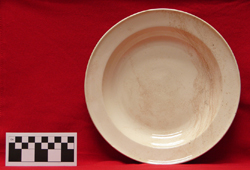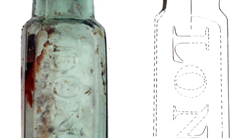Artifacts
Mardi Gras Conservation at Texas A&M University
Conservation and Identification of the Mardi Gras Shipwreck Artifacts
Conservation of the Mardi Gras Shipwreck Stern Encrustation
Ongoing Conservation of the Mardi Gras Shipwreck Artifacts and Encrustation
Ceramic Assemblage
The ceramic assemblage found on the Mardi Gras Shipwreck Site is extremely important as it provides specific information about the time in which this ship met its demise. The video footage collected thus far reveals that there are at least two ceramic types that make up the majority of the ceramic assemblage. The first of these ceramic types appears to be either earthernware or possibly stoneware. To date, only two earthernware or stoneware jugs have been identified in the video footage. The other ceramic style identified on the site is creamware. Two specimens of this type were recovered in 2004. One specimen is a plate while the other is identified as a pôt de crème, a cup used for serving a custard-like dessert.
The Ship's Stove
Several unique artifacts characterize the Mardi Gras Shipwreck. One such artifact is the ship’s cooking stove located along the western side of the site. At this time, little is known about this enigmatic artifact. Moreover, it is impossible while working from photos alone to determine if the stove is attached to the remains of an upper deck structure or some portion of a lower deck. The stove’s size poses two questions: 1) does this stove represent the remains of a galley stove used to cook for the vessel’s overall complement; and 2) could this stove represent the type of stove that would have been located in the commander’s cabin; used exclusively to heat and cook for the commander and officers of the vessel? The location of this stove and its current association with many other artifacts only fuels speculation as to its purpose and function. These questions we hope to answer with data gathered during the archaeological investigations in May 2007.
Navigation Equipment
Among the many artifacts observed on the Mardi Gras shipwreck site is a collection of navigation equipment, which includes a marine telescope, a compass (Figure 1), an octant, and three sand clocks (hour glasses). All of these artifacts are located within a few feet of each other, with the exception of one of the sand clocks, which has been identified under the weapons‘chest. By examining each of these instruments we hope to learn important clues about the vessel’s age, nationality, and perhaps even its identity.
Weapons Box
A box containing a variety of arms, including pistols, muskets, and edged weapons (such as sabers or swords) was discovered at the wreck site. These weapons contain important diagnostic information which can aid archaeologists in hypothesizing a date, nationality, and/or context for the shipwreck itself. Firearms are frequently stamped or engraved with marks indicating the manufacturer, date, national affiliation, and in the case of military arms, regimental marks and/or rack numbers. The types of weapons at the wrecksite and the shipboard location of the arms, if determinable, could indicate the purpose of the vessel for military use, trade, or for gunrunning/privateering. Many specific details regarding ownership or manufacture of the firearms and edged weapons will potentially be discovered during the conservation of the weapons.
Glassware
Home
History
Research Plan
Pictures
Videos
Daily Log
Crew





